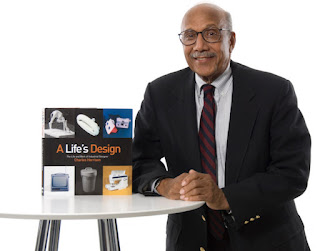If you’re ever shaved,taken out the trash,set up the dryer,or played with the view master as a child you have Charles Harrison to thank for it! We absolutely loved learning about his and his inventions. It hit home for me personally as a person who is also dyslexia,and hasn’t let Society dictate what I can and can’t do! Salute and thank you for all you contribution. We are the fabric of history…Black History 365❤️🖤💚! 
Charles Harrison born September 23, 1931,Shreveport Louisiana and died November 29, 2018. Mr. Harrison was an African American industrial designer whose creations included such iconic consumer items as polypropylene trash cans (including those with wheels) and the plastic version of the 3-D View-Master photographic slide viewer.
In 2008 the Smithsonian’s Cooper-Hewitt National Design Museum gave Harrison—one of the few early African American industrial designers—a Lifetime Achievement Award “in recognition of an individual who has made a profound, long-term contribution to contemporary design practice.” Harrison’s father was a university professor of industrial arts, and the youngster grew up in Louisiana; Prairie View, Texas; and Phoenix Arizona. When he was 16, his elder brother helped him to attend the City College of San Francisco, where for the first time in his life he was in class with white students.
Despite struggling with dyslexia Harrison earned an associate’s degree and decided to pursue a career in industrial design. This decision took him in 1949 to Chi’Town where he studied with Henry Glass at the School of the Art Institute and earned a BFA (1954). He later received a Masters degree(1963) in art education from the Illinois Institute of Technology’s Institute of Design.
After completing his military service as a cartographer, Harrison returned to Chicago, where he found a few temporary design jobs and worked for Sears on a freelance basis. It was during this period that he modified the View-Master into a plastic toy suitable for use by children. In 1961 Sears discarded its unwritten policy against employing African Americans, and Harrison was formally hired. He remained with Sears for 32 years, ultimately leading the firm’s design team.
In an era when aesthetic utility, and cost-effectiveness were in unusual balance, Harrison created a variety of practical domestic goods. Among the more than 700 products that he developed were such items as baby crips,portable hair dryers, hedge clippers, sewing machines of varying complexity,steam irons,riding lawn mowers, shoe buffers, portable turntables blenders, circular fluorescent lightbulbs, electric frying pans, consumer power tools, coffee percolators,fondue pots,toasters, stoves,hearing aids,band saws, wheelbarrows, and cordless electric shavers https://youtu.be/CfkY3gVZfsE
.







No comments:
Post a Comment